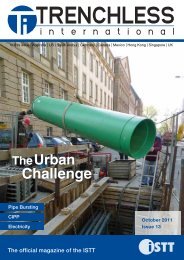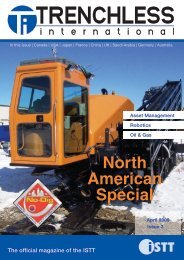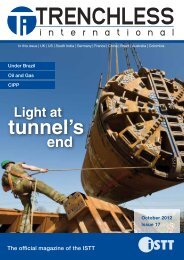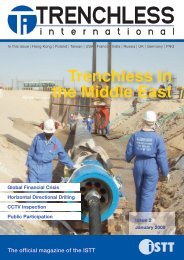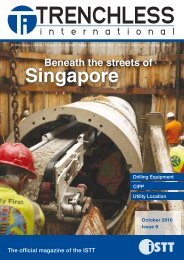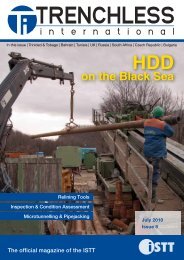Boring - Trenchless International
Boring - Trenchless International
Boring - Trenchless International
Create successful ePaper yourself
Turn your PDF publications into a flip-book with our unique Google optimized e-Paper software.
Pipe cleaning<br />
April 2010 - <strong>Trenchless</strong> <strong>International</strong><br />
The 150 mm diameter pipeline is ten<br />
kilometres in length, pumping raw water<br />
from the Dawson River to the treatment<br />
plant to service parts the Duaringa Shire,<br />
Queensland, Australia.<br />
Mission:<br />
To remove the internal debris and<br />
weed growth built up in the pipeline over<br />
a period of ten years.<br />
Due to the location of the site and<br />
the urgency of the program, Clearflow<br />
Australia worked purely on telephone<br />
communication and faxed documents<br />
in order to fabricate a pig launcher to<br />
suit the conditions onsite. After some<br />
difficulties it was made to fit and is now<br />
a permanent fixture of the pipe at the<br />
river end.<br />
Managing Director David Elderfield<br />
said “On inspection of the pipeline at the<br />
river and pumping end we adapted the<br />
existing fittings, removed a flanged section<br />
of the existing pipe and made our<br />
pig launcher fit.<br />
“The best location for the discharge<br />
was at the water plant. A section of pipe<br />
was exposed and removed with the<br />
excavation of pit leaving the open end of<br />
the pipe discharging into the settling pit.”<br />
There was no confident local knowledge<br />
of the pipeline and the only map<br />
available was a longitudinal section map,<br />
said Mr Elderfield. “It is difficult to know<br />
what to expect when launching a pig that<br />
A brush pig uses both metallic and<br />
non-metallic brushes. Generally, brushes<br />
are used when more aggressive cleaning<br />
is required to remove tough debris.<br />
Liquids pipelines are best cleaned with<br />
a pig equipped with cleaning devices<br />
attached, such as brushes, which can<br />
remove fine solids that may have settled<br />
in the pipeline.<br />
Pigs for different pipes<br />
Different pigs are recommended for<br />
water, natural gas, oil and liquids pipelines.<br />
The type of cleaning pig used on a<br />
natural gas pipeline is often determined<br />
by the internal coating of the pipe. If the<br />
pipeline is internally coated, the cleaning<br />
pig to be used won’t be equipped with<br />
cleaning devices that could damage or<br />
remove the coating. For example, a polyurethane<br />
pig won’t damage the coating. If<br />
Dawson River case study – pigging raw water line<br />
is required to travel ten kilometres and<br />
at the same time achieve the desired<br />
results.”<br />
Most of the pipeline is located in<br />
bush terrain with difficult access, with a<br />
number breaks in certain sections and<br />
unknown debris in the pipe.<br />
As the pipeline had no offshoot<br />
sections or designed breaks it was necessary<br />
for the pig to travel the entire<br />
ten kilometres and achieve the desired<br />
result. If the wrong type of pig is used<br />
and too much debris is dislodged too<br />
early the pig could jam up in the pipe.<br />
On the other hand, if the pig is too soft<br />
it may break up during the run. Or if the<br />
pig travels too quickly we may not get a<br />
true idea on the condition of the pipe or<br />
the type and amount of debris that is in<br />
the pipe to be removed.<br />
At the time of fitting the launcher the<br />
pipeline showed signs of encrustation<br />
with a large amount of weed slime and<br />
sludge – the aftermath of pumping raw<br />
water.<br />
Clearflow’s normal procedure on the<br />
first run is to try and determine the<br />
condition of the pipe. The first run took<br />
approximately four hours to travel the<br />
pipe, removing large amounts of sludge<br />
and slime.<br />
This initial run was not without complications.<br />
The pig did jam up with the<br />
amount of debris in the pipe and it was<br />
decided to release the pressure in the<br />
the natural gas pipeline is free of internal<br />
coating, a cleaning pig with brushes can<br />
be used.<br />
Plastic-bristle foam pigs can also be<br />
used with internally coated pipelines or<br />
plastic lines such as PVC, fibreglass and<br />
high-density polyethylene. The bristles are<br />
forceful enough to remove most build-up<br />
but not harmful to the coatings.<br />
Oil pipelines may need pigging to<br />
remove wax accumulations on the<br />
inside of the pipe wall or an accumulation<br />
of water in the pipe. A polyurethane<br />
pig is suitable for removing wax from an<br />
oil pipeline.<br />
It is important that the right cleaning<br />
pig is chosen for an operator’s pigging<br />
needs. There are a number of suppliers<br />
in Australia providing different pigging<br />
products, all willing to help with the right<br />
pigging solution.<br />
pipe. In doing so, Clearflow drained<br />
some of the pipe to get another run<br />
with the pig and to try and dislodge the<br />
debris.<br />
Under normal conditions the first-run<br />
pigs or proving pigs will float, however,<br />
in this case, when they were finally discharged<br />
from the pipe they were so full<br />
of sludge and slime that they just settled<br />
on the bottom of the discharge pond.<br />
They were stuck in the sludge and at the<br />
bottom of the pit.<br />
It is necessary when refurbishing pipelines<br />
to try and control the speed of the<br />
pigs through the pipeline. After two proving<br />
runs, the company was confident<br />
the pipeline was reasonably true and<br />
launched the working pig; a harder compound,<br />
poly-foam pig.<br />
The purpose of running this pig was to<br />
remove all of the debris of weed sludge<br />
and slime as well as any harder encrustation.<br />
The results achieved were very<br />
good. Clearflow not only removed large<br />
amounts of raw water slime sludge and<br />
weed growth, but also the heavy scale<br />
evident in the bottom of the discharge<br />
pit. There were also signs of manganese<br />
mixed up with the weed growth.<br />
The final analysis<br />
Improved water quality delivery with<br />
increased flow rate to the dam of 60 per<br />
cent. This alone decreased the operating<br />
costs of pumping water.<br />
Bigger than Texas:<br />
PPIM puts pigs on show<br />
A dynamic forum discussing key trends, products and services in the pipeline inspection sector – the 22nd<br />
Pipeline Pigging and Integrity Maintenance Conference and Exhibition was held in Houston, Texas, from 15–18<br />
February 2010.<br />
The Pipeline Pigging and Integrity<br />
Maintenance (PPIM) Conference and<br />
Exhibition, organised by Tiratsoo<br />
Technical, a division of Great Southern<br />
Press, and Clarion, drew engineering<br />
management and field operating personnel<br />
from both transmission and distribution<br />
companies concerned with improved<br />
operations and integrity management.<br />
Reporter Lyndsie Mewett was in attendance<br />
and here delivers a wrap of the pigs,<br />
people and program at PPIM.<br />
The event encompassed training<br />
courses, a varied Conference program<br />
and an Exhibition including 74 companies.<br />
Approximately 1,500 people<br />
attended, with 400 delegates representing<br />
22 countries enrolled in the Conference<br />
and training courses.<br />
A captivating Conference<br />
Tiratsoo Technical Principal John<br />
Tiratsoo chaired the Conference sessions,<br />
which included topics such as the importance<br />
of pig trap assessment, integrity<br />
management plans, multi-diameter bidirectional<br />
pigging, magnetic flux leakage<br />
(MFL) inspection capabilities, pipeline<br />
regulatory updates, performance management<br />
assessments and remediation,<br />
and unpiggable pipelines.<br />
The Conference program also included<br />
a panel discussion on the cleanliness of<br />
pipelines from an owner/operator perspective.<br />
Six panellists from different parts<br />
of the pipeline industry outlined what<br />
‘clean’ means to them, which proved a<br />
useful insight for contractors to assess<br />
what products would best suit proponents’<br />
needs.<br />
Pigs on show<br />
In conjunction to the Conference, the<br />
well-attended Exhibition highlighted the<br />
latest products and services available<br />
to the pipeline pigging and inspection<br />
industry.<br />
Companies displaying products<br />
included A.Hak Industrial Services, Apache<br />
The Conference Panel Session in full swing.<br />
Pipeline Products, Baker Hughes Pipeline<br />
Management Group, BJ Pipeline Services,<br />
DNV, Dresser, Girard Industries, Hebna<br />
Corporation, Knapp Poly Pig, Rosen and<br />
T.D. Williamson, plus many more.<br />
Event gold sponsors BJ Pipeline<br />
Services and Rosen provided evening<br />
drinks and nibbles in the Exhibition area<br />
during the event. This gave Conference<br />
delegates and exhibitors alike a chance<br />
to talk shop in a relaxed environment or<br />
simply unwind with new and old friends.<br />
A bright future for PPIM<br />
The importance of the pipeline inspection<br />
industry continues to grow. As<br />
60 per cent of the world’s major oil and<br />
gas transmission pipelines are now more<br />
than 50 years old, keeping up with the<br />
latest inspection and rehabilitation technology<br />
is vital.<br />
The success of the 22nd PPIM<br />
Conference and Exhibition echoed this<br />
sentiment, with many Exhibitors already<br />
signing on for Houston’s 2011 PPIM event.<br />
Tiratsoo Technical's John Tiratsoo chairs the<br />
Conference sessions.<br />
PPIM training courses<br />
Seven streams of training<br />
courses were ran on the 15 and<br />
16 February, encompassing<br />
topics such as defect<br />
management, pigging and inline<br />
inspection, pipeline repair<br />
methods, performing pipeline<br />
rehabilitation and pipeline risk<br />
management.<br />
For information about future<br />
courses, visit Clarion’s website<br />
www.clarion.org<br />
In addition to the Houston PPIM<br />
Conference and Exhibition, PPIM Asia<br />
Pacific will be held later this year in<br />
November. Training courses will be<br />
held 8–9 November with the Conference<br />
beginning on Wednesday 10. Why not<br />
drop by following Singapore <strong>International</strong><br />
No-Dig?<br />
Make sure you keep an eye out for more details on PPIM Asia Pacific – visit www.clarion.org<br />
Pipe cleaning<br />
April 2010 - <strong>Trenchless</strong> <strong>International</strong><br />
50<br />
51






